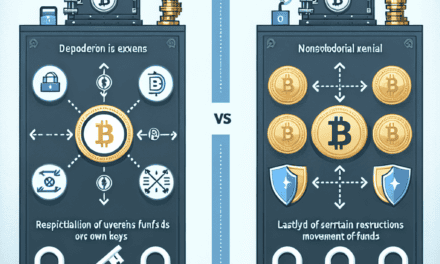“Unlocking the Future: Understanding Tokenomics in the Crypto Revolution”
Introduction
Tokenomics, a portmanteau of “token” and “economics,” is a fundamental concept in the cryptocurrency and blockchain space that examines the economic systems and models behind digital tokens. As the crypto world continues to expand and evolve, understanding tokenomics becomes increasingly crucial for investors, developers, and enthusiasts alike. It encompasses the design, distribution, and management of tokens, influencing their value, utility, and overall impact on a blockchain ecosystem. By analyzing factors such as supply mechanisms, incentive structures, and governance models, tokenomics provides insights into the sustainability and potential success of a crypto project. In a landscape where new tokens and projects emerge rapidly, grasping the principles of tokenomics is essential for making informed decisions and navigating the complexities of the digital economy.
Understanding Tokenomics: The Basics of Crypto Economics
Tokenomics, a portmanteau of “token” and “economics,” is a fundamental concept in the cryptocurrency world that refers to the economic model behind a cryptocurrency token. Understanding tokenomics is crucial for anyone looking to invest in or develop blockchain projects, as it provides insights into the potential value and utility of a token. At its core, tokenomics encompasses the design, distribution, and management of tokens within a blockchain ecosystem, influencing how these digital assets are used and perceived in the market.
To begin with, the design of a token is a critical aspect of tokenomics. This involves determining the token’s purpose, whether it serves as a medium of exchange, a store of value, or a utility token that grants access to specific services or products within a blockchain network. The design also includes the token’s supply mechanism, which can be fixed or inflationary. A fixed supply, like that of Bitcoin, can create scarcity and potentially increase value over time, while an inflationary supply might be used to incentivize network participation or maintain stability.
Transitioning to distribution, this aspect of tokenomics involves how tokens are initially allocated and circulated within the market. Initial Coin Offerings (ICOs), Security Token Offerings (STOs), and airdrops are common methods of distribution. The distribution strategy can significantly impact a token’s market dynamics and investor perception. For instance, a fair and transparent distribution can foster trust and encourage widespread adoption, whereas a concentrated distribution might lead to centralization and market manipulation.
Furthermore, the management of tokens is another vital component of tokenomics. This includes governance mechanisms that dictate how decisions are made within the blockchain network. Decentralized governance models, often implemented through smart contracts, allow token holders to vote on proposals and changes, ensuring that the community has a say in the project’s direction. Effective governance can enhance a token’s credibility and sustainability, attracting more users and investors.
In addition to these elements, tokenomics also considers the incentives and disincentives that drive user behavior within a blockchain ecosystem. Incentive structures, such as staking rewards or transaction fees, are designed to encourage participation and secure the network. Conversely, disincentives, like penalties for malicious behavior, help maintain the integrity and security of the system. By aligning the interests of all participants, a well-designed tokenomics model can create a thriving and resilient blockchain ecosystem.
Moreover, tokenomics plays a crucial role in determining a token’s market value and potential for growth. Investors often analyze tokenomics to assess the long-term viability and profitability of a cryptocurrency project. A robust tokenomics model can attract investment and drive demand, while a poorly designed model may lead to volatility and loss of confidence. Therefore, understanding the intricacies of tokenomics is essential for making informed investment decisions in the crypto space.
In conclusion, tokenomics is a multifaceted concept that encompasses the design, distribution, management, and incentive structures of cryptocurrency tokens. It is a critical factor in the success and sustainability of blockchain projects, influencing market dynamics and investor behavior. As the crypto world continues to evolve, a deep understanding of tokenomics will remain indispensable for developers, investors, and enthusiasts alike, guiding them through the complexities of this rapidly changing landscape.
The Role of Tokenomics in Cryptocurrency Valuation
Tokenomics, a portmanteau of “token” and “economics,” plays a pivotal role in the valuation of cryptocurrencies, serving as a fundamental framework that influences the economic dynamics of digital assets. As the cryptocurrency market continues to evolve, understanding tokenomics becomes increasingly crucial for investors, developers, and enthusiasts alike. At its core, tokenomics encompasses the design, distribution, and management of tokens within a blockchain ecosystem, directly impacting their value and utility.
To begin with, the supply and demand dynamics of a cryptocurrency are central to its valuation, and tokenomics provides the blueprint for these dynamics. The total supply of a token, whether it is capped or inflationary, significantly affects its scarcity and, consequently, its market value. For instance, Bitcoin’s capped supply of 21 million coins creates a scarcity that has contributed to its perception as “digital gold.” In contrast, tokens with inflationary models may face challenges in maintaining value unless demand consistently outpaces supply. Thus, the tokenomics model chosen by a project can either enhance or undermine its long-term value proposition.
Moreover, token distribution mechanisms are integral to tokenomics, influencing both initial and ongoing valuation. Initial Coin Offerings (ICOs), Security Token Offerings (STOs), and other distribution methods determine how tokens are allocated among investors, developers, and other stakeholders. A fair and transparent distribution can foster trust and attract a broad base of supporters, while inequitable or opaque practices may lead to skepticism and volatility. Additionally, vesting schedules and lock-up periods are often employed to prevent market manipulation and ensure that stakeholders remain committed to the project’s success over time.
Transitioning to the utility aspect, tokenomics also defines the functional role of a token within its ecosystem. Utility tokens, for example, are designed to provide access to a platform’s services or products, thereby creating intrinsic demand. The more essential a token is to the functioning of its ecosystem, the higher its potential value. This utility-driven demand can be a stabilizing force, as it ties the token’s value to the success and adoption of the underlying platform. Conversely, tokens lacking clear utility may struggle to maintain value, as speculative interest alone is often insufficient for long-term sustainability.
Furthermore, governance mechanisms embedded within tokenomics frameworks can significantly impact valuation. Decentralized governance models, where token holders have voting rights on key decisions, can enhance community engagement and project resilience. By aligning the interests of developers and users, such models can foster a sense of ownership and accountability, potentially leading to more sustainable growth. However, poorly designed governance structures may result in decision-making gridlock or power concentration, undermining the project’s credibility and value.
In addition to these factors, tokenomics also encompasses incentives and rewards systems that drive user behavior and network participation. Staking rewards, liquidity mining, and other incentive mechanisms are designed to encourage active involvement and support network security. These incentives can create positive feedback loops, where increased participation leads to greater network value and, in turn, higher token valuation. However, if not carefully calibrated, these systems can also lead to inflationary pressures or unsustainable growth.
In conclusion, tokenomics is a multifaceted discipline that plays a critical role in the valuation of cryptocurrencies. By shaping supply and demand dynamics, distribution mechanisms, utility, governance, and incentives, tokenomics provides the foundation upon which digital assets derive their value. As the crypto landscape continues to mature, a nuanced understanding of tokenomics will be essential for navigating the complexities of this rapidly evolving market.
How Tokenomics Influences Investor Decisions
Tokenomics, a portmanteau of “token” and “economics,” plays a pivotal role in shaping investor decisions within the cryptocurrency landscape. As the digital asset market continues to evolve, understanding the intricacies of tokenomics becomes increasingly essential for investors seeking to make informed decisions. At its core, tokenomics encompasses the economic model behind a cryptocurrency, including its supply, distribution, and utility. These elements collectively influence the perceived value and potential growth of a digital asset, thereby guiding investor behavior.
To begin with, the supply mechanism of a cryptocurrency is a fundamental aspect of tokenomics that significantly impacts investor decisions. Cryptocurrencies can have either a fixed or an inflationary supply. Bitcoin, for instance, is renowned for its capped supply of 21 million coins, which creates a scarcity effect akin to precious metals like gold. This scarcity can drive demand and, consequently, the price, making it an attractive investment for those seeking a hedge against inflation. Conversely, cryptocurrencies with an inflationary supply model, such as Ethereum, which has no fixed supply cap, may appeal to investors who prioritize network growth and utility over scarcity.
In addition to supply, the distribution of tokens is another critical factor in tokenomics that influences investor sentiment. A fair and transparent distribution model can enhance trust and attract a broader investor base. Initial Coin Offerings (ICOs), for example, have been scrutinized for their distribution practices, where a significant portion of tokens is often allocated to founders and early investors. Such practices can lead to concerns about centralization and potential market manipulation, deterring cautious investors. On the other hand, projects that employ decentralized distribution methods, such as airdrops or community mining, may be perceived as more equitable and appealing to investors who value decentralization and community involvement.
Furthermore, the utility of a token is a crucial component of tokenomics that can sway investor decisions. Tokens that offer tangible utility within their respective ecosystems are often more attractive to investors. For instance, tokens that provide access to a platform’s services, enable governance participation, or facilitate transactions within a network can create intrinsic demand. This demand, in turn, can drive the token’s value, making it a compelling investment opportunity. Investors are likely to favor projects with clear use cases and a well-defined roadmap for future development, as these factors can indicate the potential for long-term growth and sustainability.
Moreover, tokenomics can also encompass mechanisms such as staking, burning, and rewards, which can further influence investor behavior. Staking, for instance, allows investors to earn passive income by holding and supporting the network, thereby incentivizing long-term investment. Token burning, which involves permanently removing tokens from circulation, can create deflationary pressure, potentially increasing the token’s value over time. Reward mechanisms, such as liquidity mining, can attract investors by offering additional tokens as incentives for providing liquidity to decentralized exchanges.
In conclusion, tokenomics is a multifaceted concept that significantly impacts investor decisions in the crypto world. By understanding the supply dynamics, distribution models, utility, and additional mechanisms associated with a cryptocurrency, investors can better assess the potential risks and rewards of their investments. As the cryptocurrency market continues to mature, a comprehensive understanding of tokenomics will remain a vital tool for investors seeking to navigate this complex and rapidly evolving landscape.
Tokenomics and Its Impact on Blockchain Governance

Tokenomics, a portmanteau of “token” and “economics,” is a fundamental concept in the cryptocurrency and blockchain space that refers to the economic model and ecosystem surrounding a particular token. It encompasses the design, distribution, and management of tokens within a blockchain network, and plays a crucial role in shaping the governance and sustainability of these decentralized systems. Understanding tokenomics is essential for anyone involved in the crypto world, as it directly impacts the value, utility, and functionality of a token, as well as the overall health of the blockchain network.
At the heart of tokenomics is the token itself, which can serve various purposes within a blockchain ecosystem. Tokens can represent assets, grant access to services, or even confer governance rights. The design of a token’s economic model is critical, as it determines how the token will be used and how it will interact with other elements of the blockchain. This includes decisions about the token’s supply, distribution mechanisms, and incentives for users and developers. A well-designed tokenomics model can encourage participation, foster innovation, and ensure the long-term viability of a blockchain project.
One of the key aspects of tokenomics is the token supply model, which can be either fixed or inflationary. A fixed supply model, like that of Bitcoin, limits the total number of tokens that can ever be created, creating scarcity and potentially increasing value over time. In contrast, an inflationary model allows for the continuous creation of new tokens, which can be used to incentivize network participants or fund development. The choice between these models can significantly impact the governance of a blockchain, as it influences how resources are allocated and how power is distributed among stakeholders.
Another important component of tokenomics is the distribution mechanism, which determines how tokens are initially allocated and how they are distributed over time. This can include methods such as initial coin offerings (ICOs), airdrops, or mining rewards. The distribution mechanism can affect the decentralization of a network, as it influences who holds the tokens and how much influence they have over the network’s governance. A fair and transparent distribution model can help ensure that power is not concentrated in the hands of a few, promoting a more democratic and resilient blockchain ecosystem.
In addition to supply and distribution, tokenomics also involves the creation of incentives for network participants. These incentives can take the form of rewards for validating transactions, providing liquidity, or contributing to the development of the network. By aligning the interests of different stakeholders, a well-designed incentive structure can encourage collaboration and innovation, driving the growth and success of a blockchain project.
Furthermore, tokenomics plays a vital role in blockchain governance by determining how decisions are made within a network. Governance models can vary widely, from centralized systems where a single entity has control, to decentralized autonomous organizations (DAOs) where token holders vote on proposals. The tokenomics of a project can influence the effectiveness and fairness of its governance model, as it affects who has the power to make decisions and how those decisions are implemented.
In conclusion, tokenomics is a critical aspect of the crypto world that has a profound impact on blockchain governance. By understanding the economic models and mechanisms that underpin tokens, stakeholders can make informed decisions about their participation in blockchain networks. As the crypto space continues to evolve, the importance of tokenomics in shaping the future of decentralized systems cannot be overstated.
The Relationship Between Tokenomics and Market Liquidity
Tokenomics, a portmanteau of “token” and “economics,” is a fundamental concept in the cryptocurrency world that refers to the economic model behind a digital token. It encompasses the design, distribution, and management of tokens within a blockchain ecosystem. One of the critical aspects of tokenomics is its relationship with market liquidity, which is essential for the healthy functioning of any cryptocurrency market. Understanding this relationship is crucial for investors, developers, and anyone interested in the crypto space.
Market liquidity refers to the ease with which an asset can be bought or sold in the market without affecting its price. In the context of cryptocurrencies, liquidity is vital because it determines how quickly and efficiently transactions can be executed. A liquid market allows for smoother trading experiences, reduces price volatility, and enhances the overall stability of the cryptocurrency. Tokenomics plays a significant role in influencing market liquidity through various mechanisms.
Firstly, the supply and demand dynamics of a token are central to its liquidity. Tokenomics involves the careful planning of a token’s supply, including its total supply, issuance rate, and distribution method. A well-designed tokenomics model ensures that there is a balanced supply of tokens in the market, which can help maintain liquidity. For instance, if a token has a limited supply but high demand, it may lead to increased liquidity as traders are eager to buy and sell the token. Conversely, an oversupply of tokens with low demand can result in illiquidity, making it difficult for traders to execute transactions without significant price changes.
Moreover, token distribution strategies are crucial in shaping market liquidity. Tokenomics often involves decisions about how tokens are allocated among different stakeholders, such as developers, investors, and the community. A fair and transparent distribution can enhance liquidity by ensuring that tokens are widely held and actively traded. For example, if a large portion of tokens is concentrated in the hands of a few holders, it can lead to liquidity issues as these holders may not trade frequently. On the other hand, a broad distribution among a diverse group of participants can facilitate more active trading and improve liquidity.
In addition to supply and distribution, token utility is another factor that influences liquidity. Tokens with clear and valuable use cases are more likely to be in demand, which can enhance their liquidity. When a token is integral to the functioning of a platform or provides access to valuable services, users are more inclined to hold and trade it. This increased activity can lead to a more liquid market. Conversely, tokens with limited or unclear utility may struggle to attract interest, resulting in lower liquidity.
Furthermore, tokenomics can impact liquidity through mechanisms such as staking and burning. Staking involves locking up tokens to support network operations, which can reduce the circulating supply and potentially increase liquidity by creating scarcity. Burning, the process of permanently removing tokens from circulation, can also influence liquidity by decreasing supply and potentially increasing demand. These mechanisms, when used strategically, can help maintain a healthy balance between supply and demand, thereby supporting market liquidity.
In conclusion, the relationship between tokenomics and market liquidity is intricate and multifaceted. By carefully designing the economic model of a token, developers can influence its liquidity and, consequently, its success in the market. Understanding this relationship is essential for anyone involved in the cryptocurrency space, as it can provide insights into the potential risks and opportunities associated with different tokens. As the crypto world continues to evolve, the importance of tokenomics in shaping market dynamics and liquidity will only grow, making it a critical area of study for investors and developers alike.
Tokenomics: A Key Factor in Project Sustainability
Tokenomics, a portmanteau of “token” and “economics,” is a fundamental concept in the cryptocurrency world that plays a crucial role in determining the sustainability and success of blockchain projects. As the digital landscape continues to evolve, understanding tokenomics becomes increasingly important for investors, developers, and enthusiasts alike. At its core, tokenomics encompasses the design, distribution, and management of tokens within a blockchain ecosystem, influencing how these digital assets are utilized and valued.
To begin with, the design of a token is a critical aspect of tokenomics. This involves decisions about the token’s supply, utility, and governance. The total supply of a token, whether fixed or inflationary, can significantly impact its value over time. A fixed supply, like that of Bitcoin, can create scarcity, potentially driving up demand and value. Conversely, an inflationary supply might be used to incentivize network participation or fund development, but it risks diluting value if not managed carefully. Furthermore, the utility of a token—its purpose and function within the ecosystem—determines its demand. Tokens can serve various roles, such as facilitating transactions, granting access to services, or enabling governance rights. A well-defined utility can enhance a token’s attractiveness and drive its adoption.
In addition to design, the distribution of tokens is another pivotal element of tokenomics. The initial distribution strategy can influence a project’s decentralization and community engagement. For instance, a fair launch, where tokens are distributed widely and equitably, can foster a strong, decentralized community. On the other hand, a concentrated distribution, where a small group holds a significant portion of tokens, might lead to centralization and potential manipulation. Moreover, mechanisms like vesting schedules and lock-up periods are often employed to align the interests of early investors and team members with the long-term success of the project, preventing sudden sell-offs that could destabilize the token’s value.
Transitioning to the management of tokens, this aspect involves ongoing decisions about token supply adjustments, reward mechanisms, and governance structures. Effective management ensures that the tokenomics model remains aligned with the project’s goals and market conditions. For example, some projects implement token burn mechanisms to reduce supply and increase scarcity, potentially boosting value. Others might introduce staking or yield farming to incentivize holding and participation, thereby enhancing network security and engagement. Governance structures, often facilitated through decentralized autonomous organizations (DAOs), empower token holders to influence project decisions, fostering a sense of ownership and community involvement.
Furthermore, tokenomics is not only about internal project dynamics but also about external market factors. The interplay between tokenomics and market forces can significantly impact a project’s sustainability. Market sentiment, regulatory developments, and technological advancements can all influence token value and adoption. Therefore, a robust tokenomics model must be adaptable, allowing for adjustments in response to changing external conditions.
In conclusion, tokenomics is a multifaceted discipline that is integral to the sustainability of blockchain projects. By carefully designing, distributing, and managing tokens, projects can create ecosystems that are not only economically viable but also resilient to market fluctuations. As the crypto world continues to mature, a deep understanding of tokenomics will be essential for stakeholders seeking to navigate this dynamic landscape successfully. Through thoughtful tokenomics, projects can achieve long-term sustainability, fostering innovation and growth in the ever-evolving digital economy.
Comparing Tokenomics Across Different Cryptocurrencies
Tokenomics, a portmanteau of “token” and “economics,” is a critical concept in the cryptocurrency world, encompassing the economic model and policies governing a digital token’s creation, distribution, and utility. As the cryptocurrency landscape continues to evolve, understanding the nuances of tokenomics becomes increasingly important for investors, developers, and enthusiasts alike. By comparing tokenomics across different cryptocurrencies, one can gain insights into how these digital assets function and what makes them unique.
To begin with, Bitcoin, the pioneer of cryptocurrencies, offers a straightforward tokenomics model. Its supply is capped at 21 million coins, with new bitcoins being mined approximately every ten minutes. This scarcity is a fundamental aspect of Bitcoin’s value proposition, akin to precious metals like gold. The halving events, occurring roughly every four years, reduce the block reward for miners by half, thereby decreasing the rate of new supply and potentially increasing demand. This deflationary model is designed to ensure that Bitcoin remains a store of value over time.
In contrast, Ethereum, the second-largest cryptocurrency by market capitalization, presents a more flexible tokenomics structure. Unlike Bitcoin, Ethereum does not have a fixed supply cap. Instead, its monetary policy is subject to change through community consensus and network upgrades. The recent transition to Ethereum 2.0 and the implementation of the EIP-1559 proposal have introduced a mechanism to burn a portion of transaction fees, effectively reducing the net issuance of Ether. This dynamic approach to tokenomics allows Ethereum to adapt to the evolving needs of its ecosystem, particularly as it shifts from a proof-of-work to a proof-of-stake consensus mechanism.
Moving beyond these well-known examples, newer cryptocurrencies often experiment with innovative tokenomics models to differentiate themselves. For instance, Binance Coin (BNB) employs a unique burn mechanism where a portion of the tokens used for transaction fees on the Binance platform is periodically destroyed. This deflationary tactic aims to increase scarcity and, consequently, the value of the remaining tokens. Additionally, BNB’s utility extends beyond transaction fees, as it can be used for various purposes within the Binance ecosystem, such as participating in token sales and earning rewards.
Another intriguing example is Cardano, which emphasizes a research-driven approach to its tokenomics. Cardano’s native token, ADA, is designed to facilitate transactions and governance within its proof-of-stake network. The platform’s treasury system allocates a portion of transaction fees to fund future development and community initiatives, ensuring the long-term sustainability of the ecosystem. This model highlights the importance of aligning economic incentives with network growth and innovation.
Furthermore, decentralized finance (DeFi) projects often introduce complex tokenomics to incentivize user participation and liquidity provision. For example, Uniswap’s governance token, UNI, grants holders voting rights on protocol upgrades and fee structures. This decentralized governance model empowers the community to shape the platform’s future while aligning the interests of users and developers.
In conclusion, comparing tokenomics across different cryptocurrencies reveals the diverse strategies employed to achieve various economic objectives. While some projects prioritize scarcity and deflationary models, others focus on adaptability and community-driven governance. Understanding these differences is crucial for stakeholders to make informed decisions and appreciate the underlying mechanics that drive the value and utility of digital assets. As the crypto world continues to innovate, tokenomics will remain a vital area of study, shaping the future of finance and digital economies.
Q&A
1. **What is tokenomics?**
Tokenomics refers to the economic model and structure behind a cryptocurrency or token, including its creation, distribution, supply, and demand dynamics.
2. **Why is tokenomics important in the crypto world?**
Tokenomics is crucial because it influences a token’s value, utility, and adoption, impacting investor confidence and the long-term viability of a cryptocurrency project.
3. **What are the key components of tokenomics?**
Key components include token supply (total, circulating, and maximum supply), distribution mechanisms, utility, inflation/deflation mechanisms, and governance models.
4. **How does token supply affect tokenomics?**
Token supply affects scarcity and value; a limited supply can create scarcity, potentially increasing value, while an unlimited supply might lead to inflation and devaluation.
5. **What role does utility play in tokenomics?**
Utility determines how a token can be used within its ecosystem, influencing demand. Higher utility can lead to increased adoption and value.
6. **How do distribution mechanisms impact tokenomics?**
Distribution mechanisms, such as initial coin offerings (ICOs) or airdrops, affect how tokens are allocated and who holds them, impacting market dynamics and decentralization.
7. **What is the significance of governance in tokenomics?**
Governance models determine how decisions are made within a crypto project, affecting its adaptability, community involvement, and long-term success.
Conclusion
Tokenomics, the study of the economic systems and models behind cryptocurrencies, is crucial in understanding the value and functionality of digital assets within the crypto world. It encompasses the design and implementation of token distribution, supply mechanisms, and incentive structures that drive user engagement and network growth. Effective tokenomics can enhance a cryptocurrency’s utility, stability, and adoption by aligning the interests of developers, investors, and users. As the crypto market evolves, robust tokenomics becomes increasingly important in differentiating projects, ensuring sustainability, and fostering trust within decentralized ecosystems. Ultimately, tokenomics plays a pivotal role in shaping the future of digital finance by influencing how cryptocurrencies are perceived, utilized, and integrated into the broader economy.





